Harper's BAZAAR NewGen Award 2023: Meet The 12 Semi-Finalists
We welcome another twelve promising young designers to our flagship programme, BAZAAR NewGen, now in its tenth year.
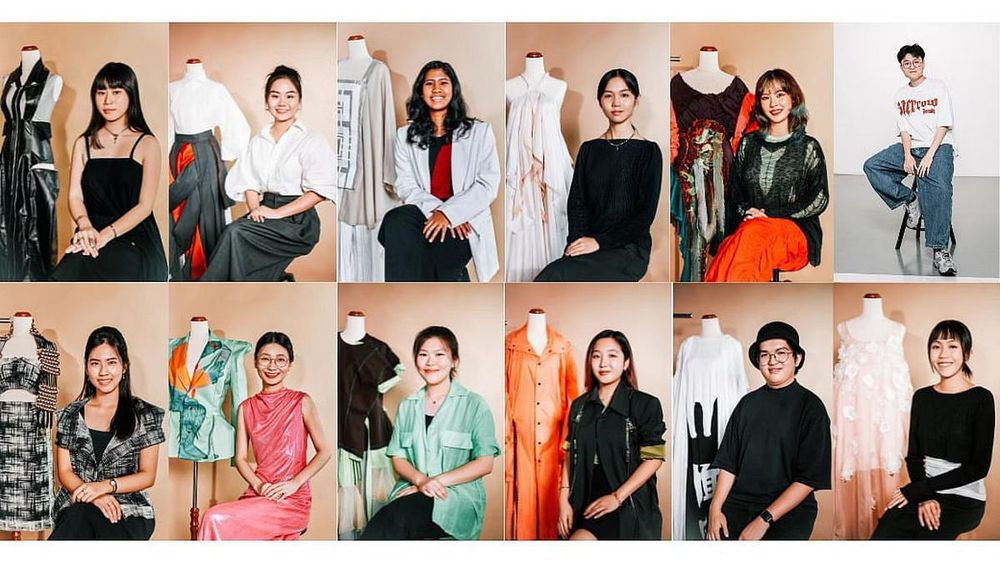
Harper’s BAZAAR Singapore’s flagship event, the prestigious Harper’s BAZAAR NewGen Award, is back and better than ever, marking its ten-year anniversary this year. First launched in 2013, this annual fashion design competition has honed the talents of dozens of final year fashion students over the years, fostering the next generation of young design talent in Singapore.
Chosen as much for the creativity and originality of their designs as well as the commercial viability and entrepreneurial vision behind their business plans, the competition has always aimed to give students the once-in-a-lifetime opportunity to gain real-world experience and exposure in the field of fashion. Not only does the winner walk away with a prize of $10,000 in cash, they will also get the opportunity to develop their final year project into a fully-fledged fashion brand, and study abroad, fully sponsored, at the London campus of Istituto Marangoni – experiences you can’t put a price tag on (though if you’re curious, the sponsorship is worth over SG$50,000).
Along the way, BAZAAR NewGen contestants gain invaluable insights from industry titans throughout the programme, through a series of mentorship sessions helmed by experienced editors and experts at Harper’s BAZAAR Singapore and CHANEL Singapore. With specific training focused on topics like marketing, visual merchandising as well as how to build a brand in the digital and social media age, young designers emerge from the competition more knowledgeable and confident in their skills.
Read more below about this year’s 12 semi-finalists, who come from across the region and represent three of Singapore’s premier arts and design schools: LASALLE College of the Arts, Nanyang Academy of Fine Arts (NAFA), and Raffles College of Higher Education.
Alison Oh, LASALLE College of the Arts
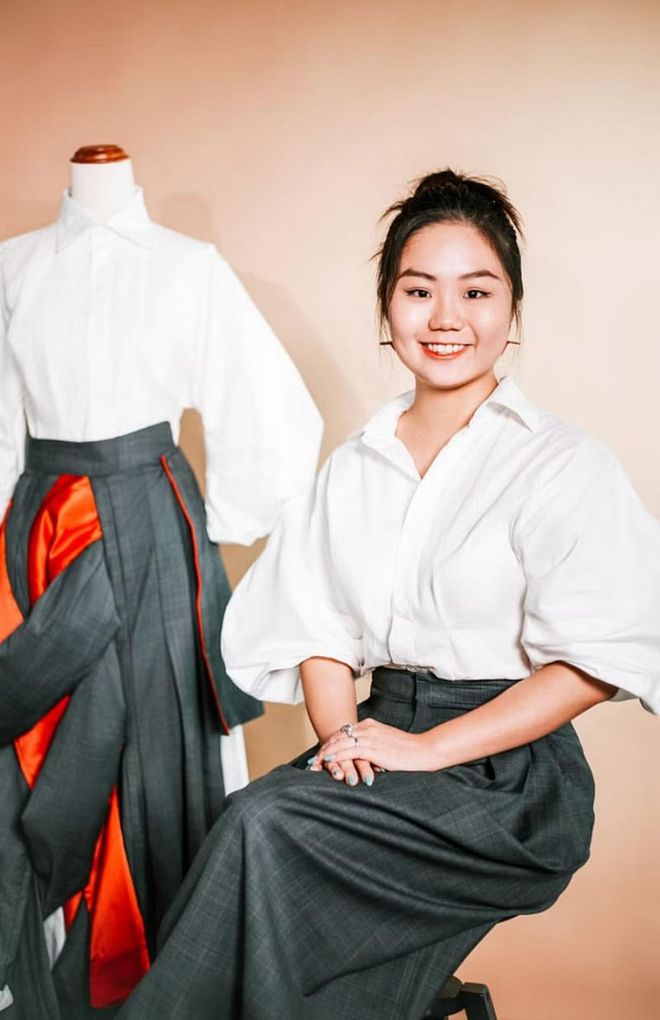
Photo: Navin Pillay
Collection: Have You Eaten Yet?
As the name of her collection might suggest, Alison Oh draws inspiration from food – Chinese food, to be exact. Specifically drawing on motifs from dim sum, traditionally shared with friends and family over a good yum cha brunch, the collection brings life to the idea that food is the ultimate Asian love language. “It’s to show how Singaporean Chinese show their affection through food itself, instead of verbal confessions,” Alison explains.
A highlight? Dumpling sleeves, which look a lot more elegant than they sound. Made with cotton twill and satin lining, the sleeves give a whole new meaning to fashion’s current obsession with all things puffy, delicately folded to form a beautiful power-shoulder silhouette.
Equal parts edgy and playful, Alison says “the garments can be worn in various ways to deliver a heartfelt message.” Intricate Chinese knots – which can be worn across the shoulder, around the torso, and many other imaginative ways – and body-hugging fabrics work together to illustrate Alison’s aims of encouraging more affection in Asian families, where cultural norms may rule out more obvious forms of physical expression in favour of subtle displays of love.
“I aim to encourage human interaction through my collection by integrating the concept of giving and receiving into the garments,” Alison continues, exploring the use of draping to imitate the visual of two people embracing. Traditional patterns and motifs meet modern silhouettes in the asymmetrically-cut layers of Alison’s pieces, which bring together the nostalgia of family gatherings past and fashion-forward design sensibilities.
It’s worth noting here that these clothes appear to be made for movement; it’s hard not to imagine sashaying down Orchard Road wearing Alison’s drapery as a dress or a skirt, perhaps while making room for oneself, elbowing one’s way through the crowds wearing the dumpling sleeves. Talk about taking up space!
Feeling inspired yet? Go hug someone you love today.
Chika Orshi Hermawan, NAFA
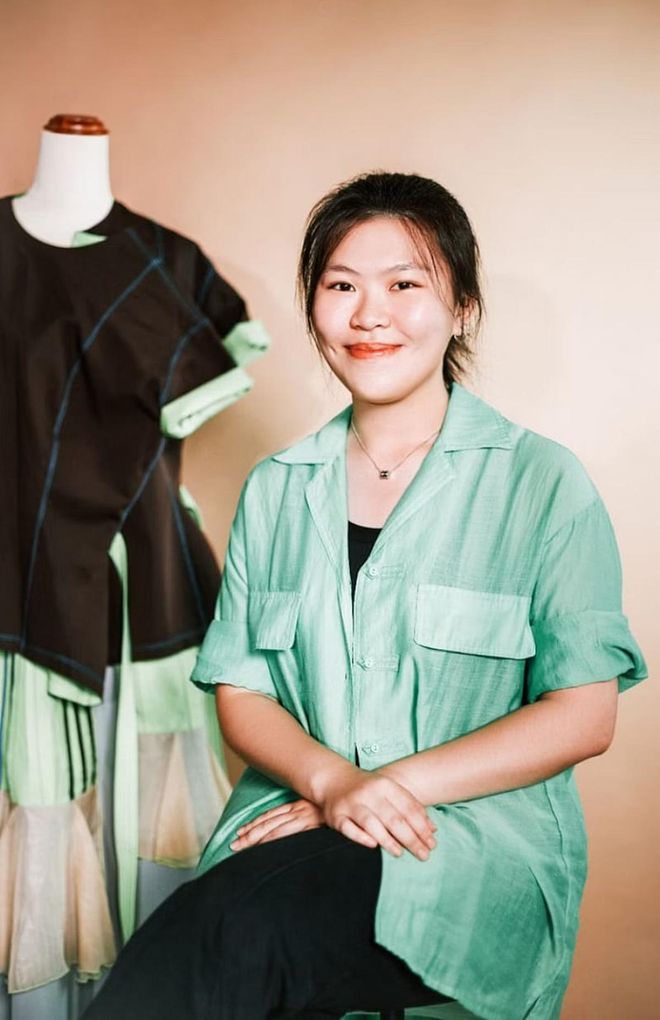
Photo: Navin Pillay
Collection: Ignorant to Rules
“Learn the rules like a pro, so you can break them like an artist.” Attributed to revolutionary painter Pablo Picasso, this quote is also at the heart of Chika Orshi Hermawan’s collection, “Ignorant to Rules.” Streetwear never looked quite as colourful – or rebellious – as it does here, where Chika breaks conventions with her offering of flowy trousers and baggy garments tinted in every colour of the rainbow.
“I also hope to disrupt people’s perceptions of fashion,” Chika says, just as Picasso changed the rules of painting and forever altered how everyday people view and engage with the fine arts. “Every garment in this collection is optimised to change the way people look at everyday fashion standards. Lots of elements can be added or subtracted from a garment.”
Call it deconstructed construction. With one of her looks, Chika defies the normal assembly of a shirt, with its one neckline, one front and back panel, and two sleeves, instead opting for an open front panel with ribbon detailing across the cutout, and two deconstructed sleeves with protruding shoulders.
Another look comes with four sleeves, creating the effect of a cape when worn, and is tied together with ribbon at the front to form a V-neck. Meanwhile, the matching skirt features two sleeves, as well, creating the illusion of layers complete with 5-striped detailing across the panels, along the hem.
The collection also takes ‘street style’ quite literally, borrowing everyday motifs from the streets to add a playful touch to the clothes, with the strap details taking inspiration from police/caution tape, while the topstitching resembles dotted-line road markings. It’s a clever subversion of the theme ‘rule breakers.’ “It reminds people to follow the traffic rules,” Chika says, “as mentioned, people tend to break them.”
The accessories accompanying her collection are where Chika truly shines. “Incorporating some styling features to elevate the outfit,” Chika says, “accessories are mainly DIY, where I utilise hardware items…bringing in whimsical tweaks with sponges, ropes, cable ties, etc.” And that’s not all – the young designer pays homage to streetwear’s sportswear roots using elements like a tennis ball for shoes and a swimming float as a leg warmer.
Who says oversized clothing can’t be super functional? Chika’s collection of cutting-edge streetwear serves to redefine everything you once thought to be true about what ‘hypebeast’ can mean – and what their clothes can do.
Feliony Faustine, Raffles College of Higher Education

Photo: Navin Pillay
Collection: Style Unbound
If you’ve ever worried about being an outfit repeater, Feliony Faustine’s collection Style Unbound may just be the right fit for you. “It’s about self-expression and individuality,” Feliony says of her pieces, which are designed to be both practical and personal for the wearer. Reversible jackets, double-headed zippers are other unique features maximise wearability while also giving the wearer the control and confidence they need to get the most out of their wardrobe.
Feliony calls Style Unbound a “blank canvas” which will “ignite customers’ imaginations and allow them to craft their own stories and concepts around each garment.” Rather than focusing on what she wants her customers to get out of the collection, Feliony says that should be entirely up to the customer and their own unique sense of style, “to interpret each item with their personal narratives, making the collection truly their own.”
Take some of those old clothes in your closet which you don’t even remember where you bought, even if you wear them day in and day out. “In the end,” Feliony says, “people often buy clothes without questioning the inspiration behind the design. It is really whether the clothes make sense or are helpful for their life.”
Style Unbound isn’t just fun, funky and easy to wear. It also makes a statement through its bold silhouettes, which Feliony intended to be genderless. “I believe clothes, especially today, should be accessible to all. To achieve this, I have adopted a relaxed oversized fit with adjustable details. Furthermore, the styles and vibrant colour palettes have been carefully selected to avoid emphasising any specific gender.”
The pieces in Style Unbound are anything but boring. Despite being oversized and gender-neutral overall, Feliony’s pieces still explore a variety of ideas, shapes and technologies in the details, from 3D pockets to removable straps on the trousers. “Those decisions are also based on my brand philosophy,” she says, “showing how versatile a collection idea can be and targeted to diverse markets with varying tastes and preferences.”
And perhaps what’s most exciting about Style Unbound is Feliony’s own ambitions for the expansion of the collection. From incorporating more sustainable ideas to toying with AI and other technologies, the young designer has big hopes and dreams for the potential of innovation in the fashion industry. All of that aside, one thing is for sure: Style Unbound is a collection which will be bringing us into the future.
Related article: NewGen 2021 Winner Justin Chua On Life At Istituto Marangoni London
Jerome Heng, LASALLE College of the Arts
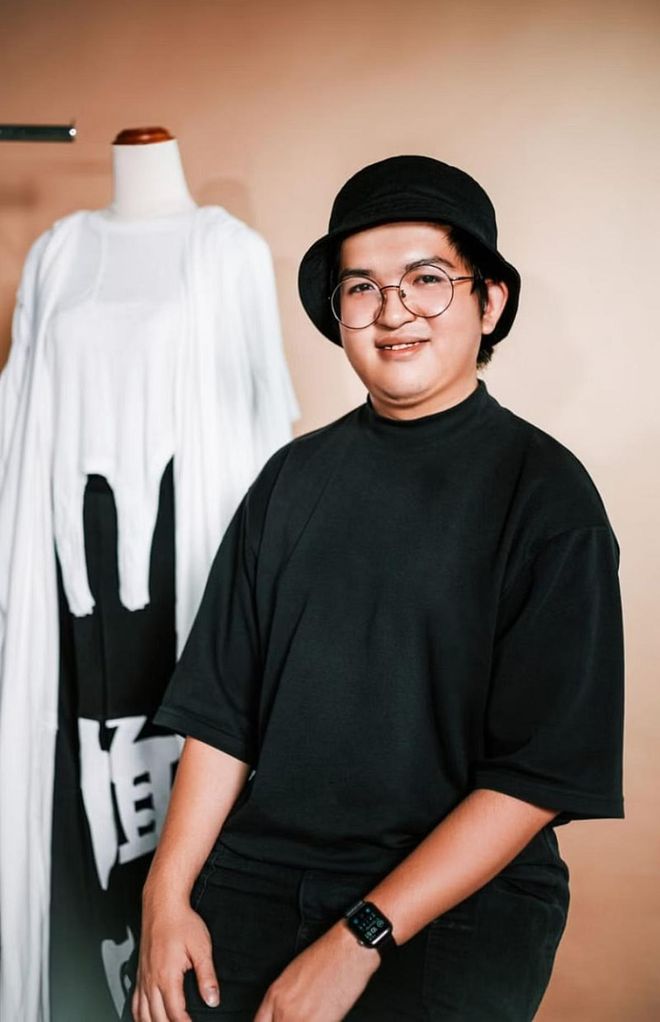
Photo: Navin Pillay
Collection: White Canvas
What can you do with an old white T-shirt? White Canvas, the brainchild of Jerome Heng, seeks to answer just that. “I started this whole upcycling thing basically from my own wardrobe,” Jerome says, “because I realised I have a whole cluster of clothes that I get influenced by watching whatever I see online.”
Both an ode to his love for white and his own sustainability journey, White Canvas uses the white T-shirt as both a motif and a medium through which the wearer can illustrate and communicate their own identity (hence the collection name). The pieces in White Canvas are made entirely from end of roll fabrics, which are usually either the last fabrics from a big factory order, or otherwise left over from designs which didn’t end up getting made.
Inspired by a hand-me-down quilt from his older brother, Jerome looks at his collection and his brand, JER., as a meditation on third-culture kids and their identities. Like the quilt, an amalgamation of different fabrics from different sources, the young designer likens his collection to living in Singapore, where different people from different cultures and walks of life live and work together to form a cohesive, harmonious society. Jerome hopes his clothes empower wearers to do the same, saying, “As a creative guide, JER. equips individuals to confidently express themselves.”
As a result, the collection is equal parts abstract and distinctive, reflecting both the ambiguous confusion and individuality which make up the third-culture identity. While it may look complex at first glance, the mish-mash of patterns, layers and fabrics clashing in Jerome’s collection come together to form something quite beautiful and avant-garde.
Through his pieces, the designer hopes to inspire wearers to look at sustainability as a method of expressing oneself, bringing out one’s own personality by being more mindful about the clothes they choose to wear. “Singaporeans have some of the highest disposable incomes in Southeast Asia, leading to consumers buying more than they need,” Jerome says. “As per a report by Straits Times, Singapore generated about 156,700 tonnes of textile and leather waste in 2015.”
By making his collection all-white, Jerome also understands the meaning of going back to basics. By stripping his items down to the bare essentials, wearers can focus more on the beauty of these nearly-forgotten fabrics; the intricacies of Jerome’s construction; and the larger themes behind his collection. Consider the upcycling of bottoms to form corset-like detailing, or the drapery which allows his blouses to double as dresses, or vice-versa.
All in all, Jerome hopes White Canvas will serve as a starting point for better sustainability practices in the fashion industry – as well as inspiration for fellow third-culture kids like himself. “My collection will learn to better understand the use of wardrobe studies,” he says, “to find how, in this current situation of globalisation, the third-culture kid is able to embrace their diversity, and find their sense of self-identity through this capsule.”
Leong Jia Yin, LASALLE College of the Arts

Photo: Navin Pillay
Collection: In Our Possession
The forces of light and nature come together in Leong Jia Yin’s collection, In Our Possession, which contemplates the idea of slowing down, stepping back and revelling in the little joys of life. “With the rapid advancements in technology, it is evident that we inhabit a realm of perpetual interconnectedness, instantaneous communication, and accelerated work environments,” Jia Yin says. Her collection, then, aims “to rediscover the unnoticed instances in our lives, to illuminate and capture these fleeting moments in our surroundings.”
Delicately-crafted flowers with detailed embroidery serve as the motif through which Jia Yin ponders on this message. “These profound moments are transformed into tangible textiles harmoniously blending simplicity and intricate detailing,” the textiles student says, “by integrating technological advancements while infusing a touch of personal craftsmanship.”
Combining translucent materials, layering and digital printing techniques as well as 3D embroidery, In Our Possession is a master class in precision and dexterity. Drawing on silhouettes influenced by nature, such as a flower bud, getting up and close with these garments reveals so much more, allowing for the multifaceted, multi-dimensional viewing experience which Jia Yin intended to have.
“The stacked layers enhance the overall aesthetic appeal and introduce intrigue and fascination as they reveal glimpses of the captivating layers beneath,” Jia Yin says of her pieces, especially the individual flowers blooming across her main highlight, look six. “Our environment shares a similar quality, consisting of multiple intricately intertwined layers to form what is perceptible. Yet, we remain oblivious to the layers that compose the complete picture.”
Eager to uncover nature’s hidden beauty through her work, Jia Yin says she aims to “expand our understanding and appreciation of the world around us” through this collection. “I draw inspiration from the boundless beauty of the natural world, recognising its inherent value and seeking to capture the same essence in garments that could evoke a sense of appreciation and longevity.” Take, for example, how the translucent materials throughout In Our Possession allow light to shine through in different ways, illustrating how light “plays a vital role in illuminating nature’s beauty, accentuating the intricate details within lush foliage and blooming flowers…casting enchanting shadows and revealing hidden subtleties that would otherwise go unnoticed.”
Taken as a whole then, In Our Possession asks viewers to consider their own relationship with nature, something Jia Yin herself takes very seriously. “This concept is a psychological construct that highlights how the environment shapes our personal identity,” she says, “and influences our perception of ourselves concerning nature. This could impact our relationship with the environment and influence our behaviours to foster a more harmonious coexistence with the natural world.”
And despite concerns over the ever-expanding influence of AI and other technologies over society and human behaviour, Jia Yin’s work goes to show that certain innovations – especially in her field of textile and embroidery – can actually go to expand what’s possible to ask of the human senses. “Regarding my collection’s tactile experience and techniques, I will continue to utilise 3D embroidery and photography on digital prints as my primary approach,” she says. “However, [I] aim to refine my techniques by experimenting with new textures and fabrics, and incorporating innovative design elements to elevate the sensory impact of the garments.”
Lim Su Hui, LASALLE College of the Arts
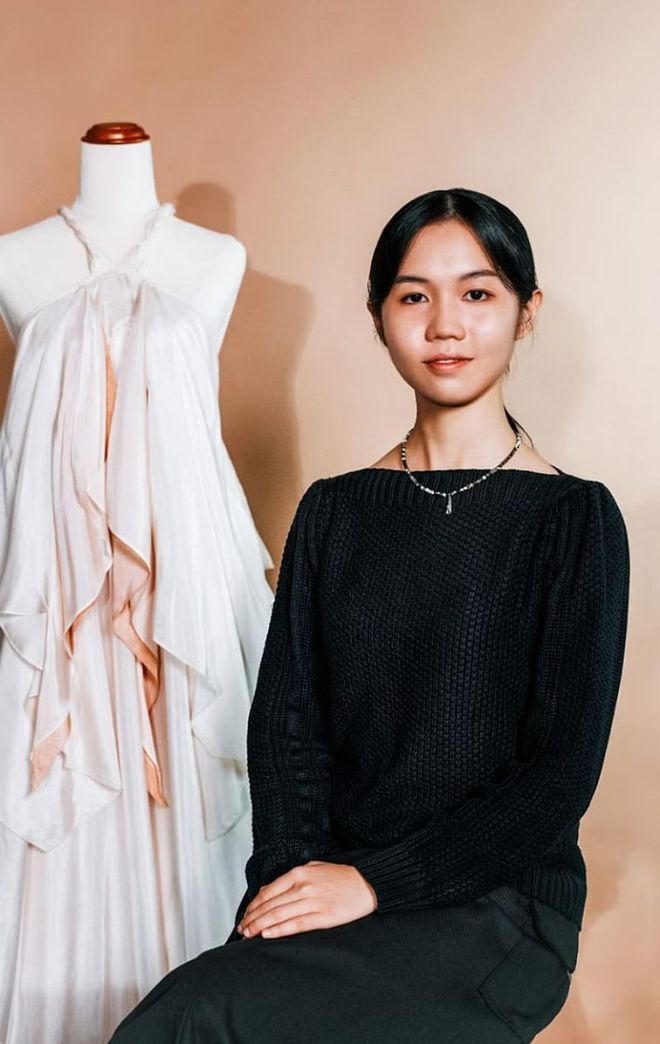
Photo: Navin Pillay
Collection: Homeland
Lim Su Hui’s neutral-toned collection, Homeland, is earthy both in its aesthetic and its message featuring elegant drapery woven from materials using an entirely zero-waste model. “Homeland is a poetic nod to Singapore’s nature and heritage landscape,” Su Hui says, using hexagons – a common shape found in nature – as the primary building block for her collection.
“Repetition is the essence of a plant,” the young designer continues, “in the form of shapes, forms, and textures. There is beauty in the symmetries and tessellated geometric forms of nature.” Those who look closely will see this symmetry reflected in Homeland, with the layers of drapery across the collection’s pieces folding into themselves over and over again to form gorgeous silhouettes of all hexagonal shapes and sizes.
It’s this simple beauty of nature which Su Hui attempts to recreate throughout Homeland, which also ruminates on the meditative, poetic nature of repetition and finding inner peace. Homeland’s pattern-cutting process also brings this idea full circle, playing on the idea that fashion, just like nature, can be regenerative when nothing is left to waste. “My designs practise zero-waste philosophy in the pattern-cutting process,” Su Hui says, “where patterns are not based on metric patterns, but rather are of shapes that can be optimised to reuse their leftovers/off-cuts effortlessly.”
The philosophy of yū is at the heart of Su Hui’s design ethos. Derived from yūgen (幽玄), which speaks of the mysterious beauty of things felt with the heart, Homeland embraces the yū philosophy by reflecting the everyday beauty Su Hui witnessed on her daily walks through Singapore’s own Fort Canning Hill. Since certain things can’t be put into words, the young designer lets her clothes speak for themselves instead; Homeland’s pieces blend in easily with the flora and fauna and flow effortlessly in the wind.
To view Su Hui’s clothes in nature is to view them exactly how she intended. In a testament to her zero-waste philosophy, Homeland also repurposes its leftovers into hand-knotted fabric strips, which are further woven and transformed into bamboo handle bags. Working with local crochet artist @koinijothreads to create this special accessory from scraps, Su Hui expertly demonstrates why sometimes, going back to our roots is just what we need to create something beautiful.
Related article: Inside Joe Kean’s Journey From BAZAAR NewGen To Charles & Keith
Nariko Prasannan, NAFA

Photo: Navin Pillay
Collection: Grandma’s Hut
In memory of her late grandmother, Nariko Prasannan’s collection, Grandma’s Hut, pays homage to the woman who raised her, and the home she grew up in. “Growing up, I spent a lot of time looking through my Popo’s collection of items and decorations,” Nariko says. “This collection doesn’t only reminisce [about] my grandmother’s house and the memories in it, it also is a tenet of my Chinese roots.”
Drawing inspiration from the rustic wooden window lattices spanning the window panes of her grandmother’s home, a common sight in older Chinese households, Nariko’s collection explores the concept of positive and negative spaces using the laser-cutting technique, to form cutouts across the front and back panels of her pieces.
“I’m not a philosopher myself, but I love philosophy,” Nariko says. “In this life where people chase after riches and material possession, I often wonder, where does contentment lie? While it may vary for people, I believe that contentment lies where we learn to be happy with the little that we have. My aesthetic has always been clean and in muted colours, because I love the simplicity in these combinations.”
The young designer says the muted colours of Grandma’s Hut also remind her of the serenity and calmness she experienced at her grandmother’s home. As a result, Nariko’s collection is both a time capsule preserving her memories of her grandmother and a vessel for carrying her legacy into the future.
Grandma’s Hut also experiments with the usage of lines and movement to explore the human form. While the lines embody stillness, Nariko notes, when worn on the human body, our movement naturally breathes life into these lines, bringing a new dimension to the designs as seen on a living model rather than a static mannequin.
Of the collection’s distinctly Asian flair, Nariko says, “I wanted to use this collection to communicate this common feeling we feel whenever we spend our time at an elderly loved one’s house. It reflects my brand identity in a way where an older person is content, and can remain still wherever they are in life.”
Sonpavorapong Sasipim, NAFA
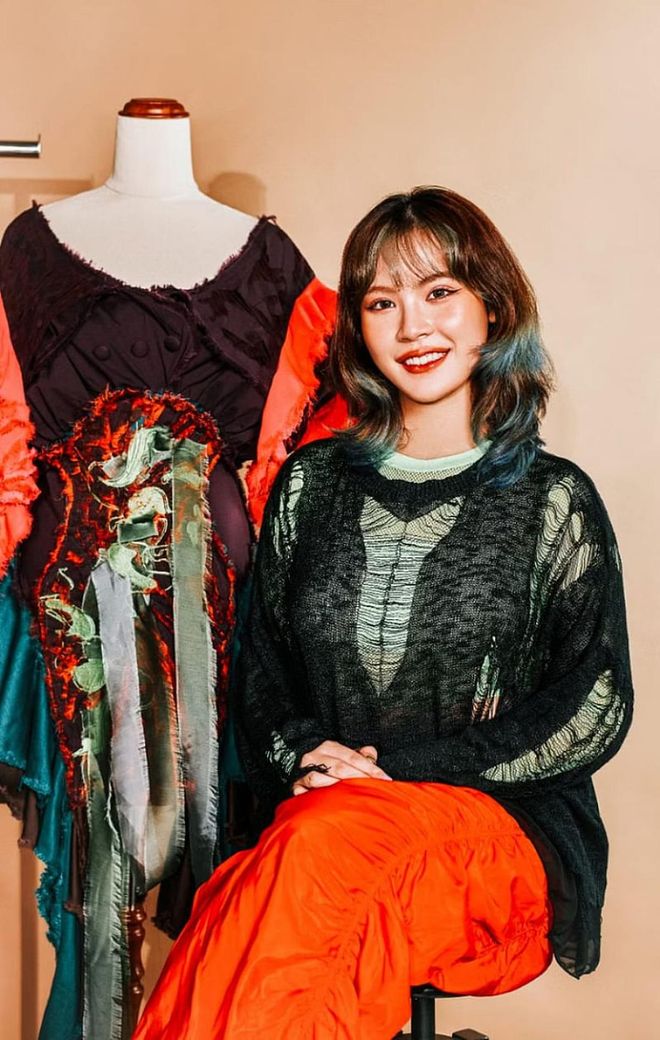
Photo: Navin Pillay
Collection: Decay & Emerge
The cycle of life comes to life through the clothes in Decay & Emerge, Sonpavorapong (Hunny) Sasipim’s collection, which explores how death, disintegration and decay give way to renewal and rebirth. Just as life and death represent two sides of the same coin, Hunny says “My design aesthetic is contrasting details. Not only fabric choices but also a mixture of silhouettes.”
As British designer Alexander McQueen once said, “It is important to look at death because it is a part of life. It is a sad thing, melancholy but romantic at the same time. It is the end of a cycle – everything has to end. The cycle of life is positive because it gives room for new things.” Citing McQueen as an inspiration, Hunny’s creations aim for the equally fantastical and explosive, unafraid of leaning towards the borderline grotesque.
“By emphasising the processing of death and incarnation as something significant, something in which we participate,” Hunny says, “the allure of impermanence and change is typically connected with the beauty of decay and emerging. It implies that objects that disintegrate or decay through time may be attractive in their own right, as they symbolise the natural cycle of development, change, and transformation.”
Hunny plays with fabric manipulation, particularly flounces, to create volume and structure out of abstract shapes and styles. (“Its flowiness represents both liveliness and lifelessness, says Hunny.) And while McQueen’s designs often looked similar to Victorian fashion, the mish-mash of vibrant fabrics and clashing colours in Decay & Emerge reinvent those McQueen-esque tights and corset silhouettes with brilliant Gen Z flair.
Each piece in Decay & Emerge plays with this contrast between past and present, form-fitting and voluminous silhouettes, synthetic and natural materials, matte and shiny fabrics, bright colours and darker, earthier tones. If death is life, then life is death, too. This establishes, in Hunny’s words, “a connection between the wearer and the environment.”
Distressed fabrics and raw edges give the collection a grungier, punk rock feel, also characteristic of designers like McQueen and Vivienne Westwood. “The concept is about finding beauty in imperfections and flaws to celebrate the natural evolution and renewal of materials, spaces, and ideas,” Hunny says. “The beauty of decay and emergence suggests that change and impermanence can be appreciated and celebrated, rather than feared or resisted. It encourages us to embrace the natural cycle of life and find beauty in all stages of the journey.”
Sri Anggreni Wicaksana, NAFA
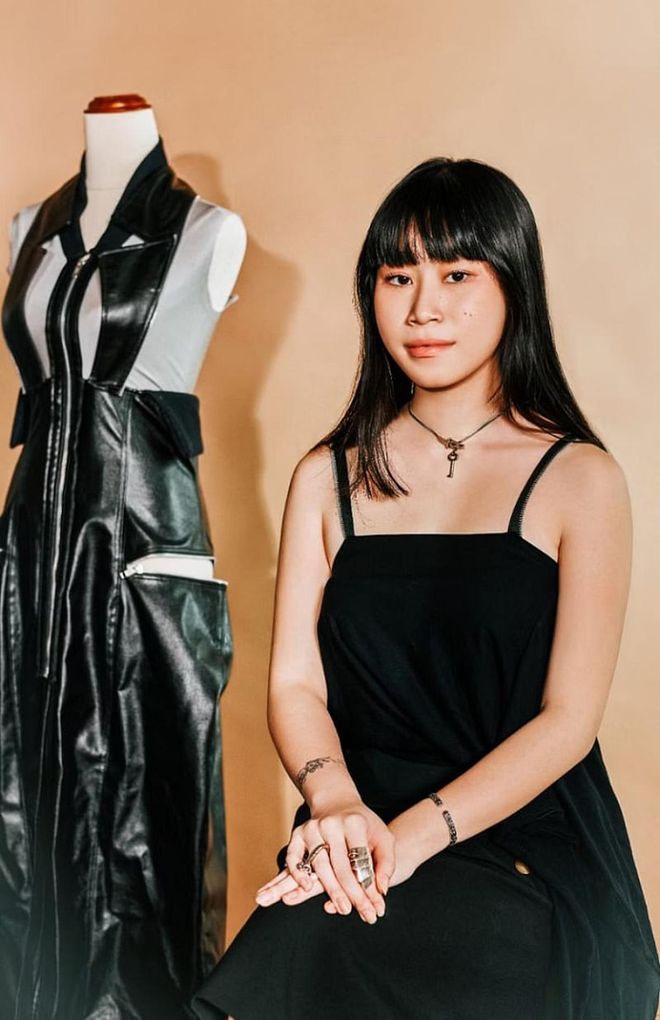
Photo: Navin Pillay
Collection: Requiem of dream (black)
Sri Anggreni Wicaksana’s collection Requiem of a Dream reimagines gothic fashion as wearable art through sculptural faux leather and – you guessed it – largely black designs. Experimenting with various different silhouettes and transformative details in her pieces, Sri goes to show that black is far from boring.
Sri likens living in the digital age to existing in a zombie-like state, as being glued to our phones ruins both our attention spans and our postures. Exposed rib cages, as on a skeleton, are a common motif throughout the collection, including the accessories, in the form of both phone cases and bags.
Of her inspirations, Sri says this collection “aims to design sculptural and transformative garments that emphasise conceptual narrative to provoke conversations and empower the wearer.” The young designer studied human evolution in doing research for the collection, studying the different ways in which overuse of modern technology has strained our muscles and distorted our bodies, reimagining these changes through interactive elements in her designs.
With this dystopian futuristic narrative, Sri says Requiem of a Dream is catered towards “edgy women” who appreciate interesting silhouettes. Take the ‘hunchback’ silhouette, for example, which mirrors the hunched-over shoulders many of us have after a long day of looking down at our phones or bending over our computer screens. With exaggerated sleeves and little features like the laser-cut satin fabric details on the back – which represent the movement of human skeletons – this collection isn’t made for the faint of heart.
Featuring “faux leather that acts as a second skin and Lycra knit to stretch and morph into the body,” Sri says Requiem of a Dream unexpectedly doubles as an athleisure collection. “Rib knit details add a sporty touch, combined with multiple zippers on leather for an edgy look.”
And contrary to the dark inspirations behind Requiem of a Dream, the collection is actually meant to be interactive, encouraging us all to think outside the traps society has put us in with those technological devices. Sri hopes “wearers can transform the garments into different designs as they wish” by playing with the zippers and changing up the silhouettes to suit one’s own body.
Related article: Higher Calling: Istituto Marangoni London’s Stelios Geros On Supporting The Next Generation Of Fashion Talent
Verina Lie, Raffles College of Higher Education
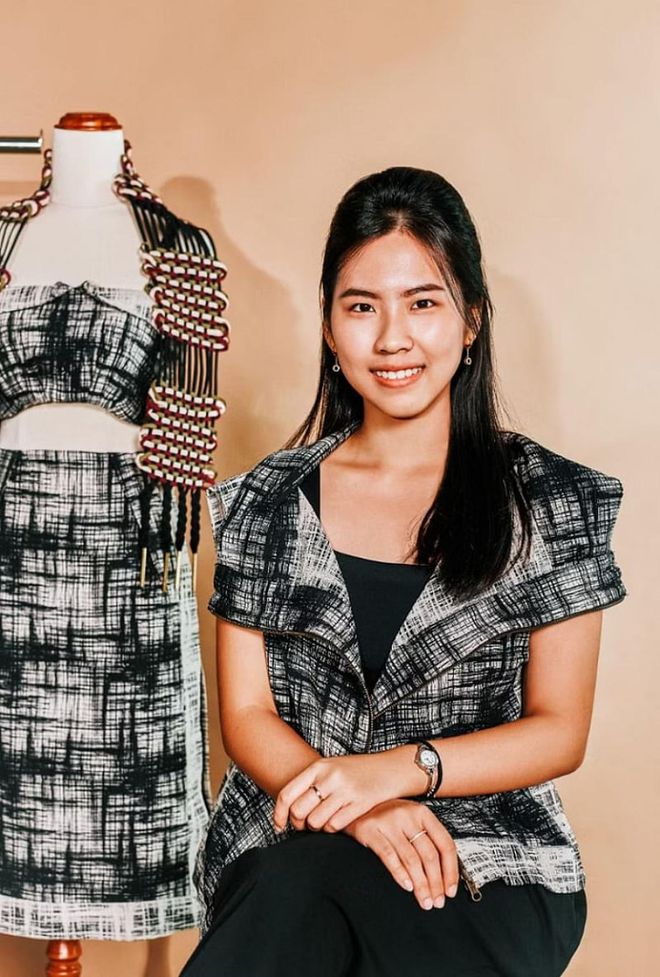
Photo: Navin Pillay
Collection: Alternate
Many of us seek a wardrobe which will continually reinvent itself without us having to replenish it with new items year after year, making shopping hauls which only further damage the environment. Verina Lie has the same idea with her collection, “Alternate,” which focuses on utilising leftover, deadstock fabrics to simultaneously reduce waste and expand the possibilities of existing materials in the supply chain.
Describing her brand as one that focuses on “construction, silhouette, and texture” while offering accessories such as bags, belts, scarves, and pouches, Lie reimagines a working woman’s wardrobe using clean, clear-cut lines and woven textures throughout her designs. But there’s more to these elegant, streamlined silhouettes than meets the eye.
A closer look at Lie’s A-line miniskirt, for example, reveals that the garment actually evolves into a handbag. A halter top from her collection, on the other hand, can be easily transformed through some simple manipulations of the fabric into different styles. The final products are at once personal and professional, able to appear as something different to the wearer and the outside world.
Lie says she hopes “Alternate” will be embraced by the “eco-conscious customer” with an eco-friendly lifestyle who also hopes to stay on trend in a fashionable world. She also hopes to help change fashion’s unhealthy production cycles with her line and zero-waste design ethos. “I want to let more people understand about this method so that we can take part to help the environment by creating less waste in the fashion industry,” she says. “I would do some workshop[s] showing people the amount of waste created and also to build awareness about it, through video campaigns.”
Last but certainly not least, Lie says she hopes to get the endorsements of celebrities and influencers to help further the wave of sustainable fashion here in Singapore, as well as work on collaborating with other brands. There couldn’t be a more collaborative method embodying the spirit of sustainable fashion than this, to promote and propel the cause into the future.
Zhou Sitong, NAFA
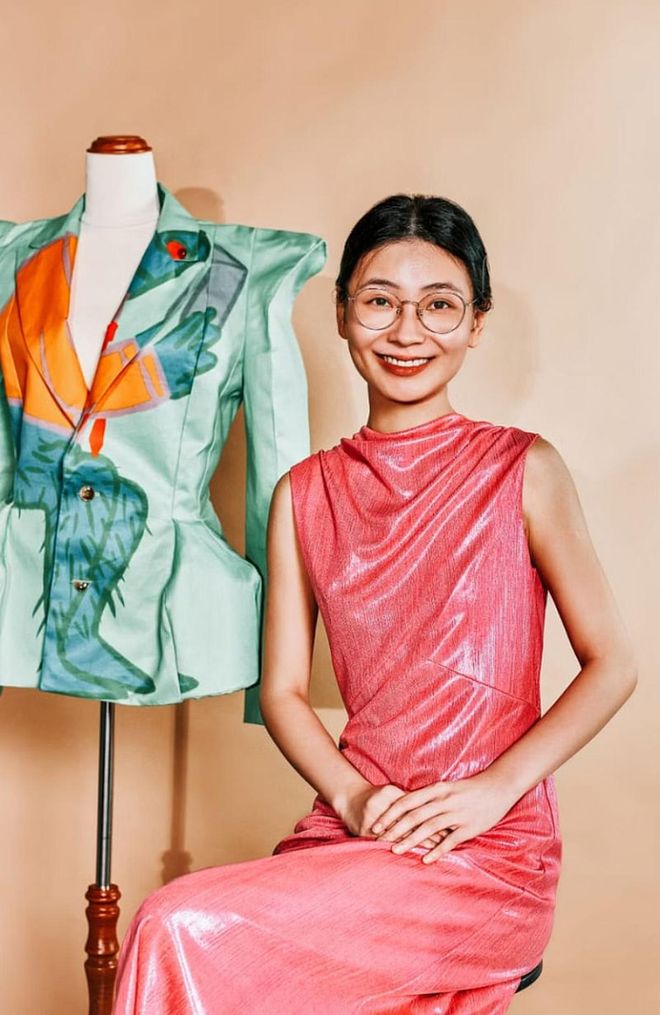
Photo: Navin Pillay
Collection: Salted Fish
Ever wanted to take a nap during the work day? Zhou Sitong hears you. As much of Gen Z, particularly Chinese youth, revolt against ‘hustle culture’ and brutal ‘996’ working hours (referring to 9AM-9PM, 6 days a week), Sitong’s collection Salted Fish honours these individuals who are rejecting societal standards and learning to stand on their own two feet. (Or rather, lie flat.)
Salted Fish refers to a common Chinese saying which describes those who want to chill out, instead of adhering to the busy lifestyle which signifies one’s social standing and definition of ‘success’ in China. Inspired by the ‘dream-core’ aesthetic, Sitong uses vibrant prints from her own illustrations for the collection which shows these ‘salted fish’ taking part in leisurely activities: reading a book, lounging back and laying around.
Similar to pop art, abstract shapes, bold silhouettes and a bright colour palette dominate the collection. Contrary to its ‘laidback’ spirit, these clothes look bold and confident, meant to be worn by those who are comfortable staying in their comfort zone. “My collection reflects how I view society and culture, as well as my own perspectives,” Siting says.
Reflecting on her own feelings living in a society which only values hard work, Sitong says, “I would expand my collection to discuss the reasons people wish to become a ‘salted fish,’ and how they feel alienated and isolated in these big fast cities. Staying in the comfort zone is nothing to [be] ashamed of. It seems like the lives of salted-fish people are boring, and ‘unsuccessful,’ while they are very happy and satisfied.”
And what screams laidback more than lying down on the couch? To develop one of Salted Fish’s looks, Sitong bought pillows, sheets and a pipeline to form the silhouette of someone padded by cushions. Perfect for taking a nap wherever you are. Another highlight is the ‘leg hair’ trousers, inspired by those who can’t be bothered to shave.
Spunky and self-realised, Salted Fish is truly a collection made for all the weirdos out there who don’t mind being called out for who they are. Whether you call them lazy or simply self-assured, the individualistic oddballs of Gen Z are here to make a statement and say it out loud: we don’t want work to be our life, so why should you?
To Guan Yu, NAFA

Photo: Navin Pillay
Collection: Second Skin
Does our fashion define us, or the other way around? For designer To Guan Yu, this thought process manifested itself through his collection, Second Skin, which Guan Yu says was inspired by designer Ding Yun Zhang and his holed puffer jacket collaboration with Moncler. The young fashion design student says the collection was born out of feeling that he himself lacked self-identity. As a designer, then, what better way to explore one’s own identity than through the concept of clothes themselves?
As our ‘second skin,’ clothes can protect us, expose us, hide us, and yes, define us. “We expose it, cover it, paint it, tattoo it, scar it, and pierce it,” says Guan Yu. “Our intimate connection with the world, skin protects us while advertising our health, our identity, and our individuality.”
Second Skin takes the concept of skin as identity to the next level by drawing on all sorts of ‘skins’ as inspiration. Guan Yu’s preliminary sketches take us on a visual journey from the texture of beef tripe to the shedding of a snake’s skin, onto the ‘sea skins’ and scales of aquatic creatures, tattoos and even burn scars. The finished product? A collection of fantastical, inflated ‘outer’ and more subdued ‘inner’ pieces, a reflection on Guan Yu’s own idea that what we display on the outside hides who we truly are on the inside.
“Is the outer always superficial?” Guan Yu asks. “Is it a selective showcase of oneself as well as a protective layer of a facade to not be vulnerable?” The pieces in Second Skin illustrate this idea in funky, colourful ways, with holes in the outer ‘shell’ around strategic areas – over one’s crotch and backside, for example – exposing the simple blue bodysuit underneath.
“The hole felt like [the] public’s gaze towards me,” Guan Yu explains, “yet it can be viewed the other way, as the one who looks through the holes as a window to see what’s under.” The collection considers skin as a physical manifestation of double consciousness, through which the wearer can consider self-perception in relation to what it means to be perceived by others. Who do we choose to show ourselves to and what parts of ourselves shine through?
The designer’s colour palette of choice also makes a statement through bright yellow, fiery red and a bold blue. Unsurprisingly, the finished pieces in his collection resemble silhouettes drawn from nature, as many living creatures use skin as a first layer of defence, a defence mechanism of sorts, like many vibrant-coloured fruits and fungi which are often not safe to consume. Speaking on what he hopes to convey through this collection, Guan Yu says the journey has been all about self-discovery. “I gained an insight into who I am, who I want to become and what kind of designer I am.”